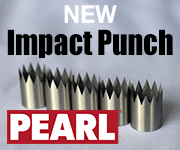Featured Stories
-
Elevating Pouch Manufacturing with Pearl Technologies' Cutting-Edge Solutions
For manufacturers seeking efficiency, precision, and safety in pouch production, Pearl delivers unmatched innovation across three standout... -
Faster Product Composition Analysis Equals Better Quality Assurance
Near Instant Testing and Reduced Costs to be Found -
Methods to Precisely Measure Tension and Web Control
How to Control Automatically Within Set Parameters
News | New Products
-
Convertech Brand to Fully Transition to Double E Group Same Team, Same Excellence, Unified Name
Double E Group has announced that Convertech, one of its subsidiaries and a trusted provider of core chucks and shaft solutions for the converting industry, will now operate solely under the Double E Group brand.
-
Pulse is Making Print Simple at Labelexpo Europe 2025
Narrow web ink specialist Pulse is Making Print Simple at Labelexpo Europe 2025, as it challenges flexo printers to rethink how they work and shows solutions that turn production bottlenecks into revenue generators.
-
ROTOCON to debut at Labelexpo Europe with three machine demonstrations
ROTOCON will make its Labelexpo Europe debut, exhibiting together with HS Machinery on stand 4D21.
-
At Interphex Japan, IL Group to Showcase Innovative Labeling Solutions and Contract Packaging Services
IL Group, a specialist in multifunctional labeling solutions for the pharmaceuticals and healthcare sectors
-
Revolutionizing Adherence: Clinical Trials Go Digital with Enhanced Key-Pak®
Keystone Folding Box Co., a leading provider of paperboard packaging solutions, has announced a strategic partnership with Med-Con Technologies
-
Innovating for Circularity: How New Sustainability Initiatives Are Shaping the Future of Labeling
In the face of growing regulatory, environmental and consumer pressures, the packaging and labeling industry continues to advance technologies and solutions that help to support a circular economy.
-
New Product Development: RKW Horizon®–MDO-PE Films with EVOH Barrier
RKW Horizon® is the new generation of sustainable PE plastic films based on the latest MDO technology.
Expert Advice
Wide Web Handling and the Problems It Can Bring
- Published: December 01, 2001, By William E. Hawkins, Film Handling Solutions Ltd.
As new film casting machines have grown in width during the past several years, so have casting machine windups. One problem that arises with wider rolls is deflection due to roll weight. Most wide casting machines wind the entire web, minus the trim, on a single mandrel. And most of these winders use a lay-on roll to remove excess boundary air from the winding surfaces.
When the web thread path is from the bottom over the top of the lay-on roll on very wide machines (see Fig. 1), the amount of deflection may cause the web to be tracked toward the machine centerline, generating slack in the middle.
Also, a problem with this configuration is the fact that as the winding roll diameter becomes greater, its deflection from weight becomes greater. On some products there can be as much as 200-300 mils additional deflection when the winding roll is at full diameter.
When there is a large difference in deflection, the nip footprint does not stay uniform as the roll builds, and the middle of the winding roll ingests more boundary air in the center area. Greater boundary air coupled with slack from the inward driving tracking forces from the deflected lay-on roll result in excess web in the roll center.
This is not visible to the observer as the web is winding, because the excess web is supported by pressure from the entrapped boundary air. However, after the roll doffs, the web wraps near the mill roll center will collapse into a waffle pattern when the excess boundary air escapes from the roll edges.
One way to reduce the amount of boundary air these wide rolls ingest is to configure the windup as shown in Fig. 2. This concept uses a bowed lay-on roll at 45 deg to spread the web as a counter for the inward tracking forces due to weight. The lay-on roll assembly moves away from the building roll in the same manner as in Fig. 1. The negative feature of having the web tension opposing the contact pressure is minor compared to the problem of deflection.
Lay-on roll bow can be accomplished by installing tilting bearing housings on the trunnions (see Fig. 3). Differential jackscrews are used in this concept to rotate the bearing housings to apply counter bending moments. The use of differential threads provides good control for applying bending moments with a wrench. The amount of thread adjustment to obtain the desired bow may be measured off-line with a dial indicator on a test stand. The roll trunnions must be able to endure the bending forces for anticipated run life. And, the spaced bearings must be robust enough to withstand the extra loads that may be applied by the differential jackscrews.
Since this is my final column, I want to take this opportunity to thank all of my readers for their interest in my articles. For the past four years I have attempted to present some web handling science that explains web behavior in converter operations. Many of you have let me know that my efforts were not futile.
I also want to thank all of the people at PFFC magazine, especially managing editor Debbie Donberg for redoing my raw materials and making them into nice, readable columns.
Lastly, I want to thank associate publisher/editor Yolanda Simonsis for giving me the opportunity to write this column. I have really enjoyed the experience.




















